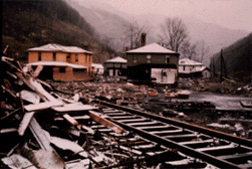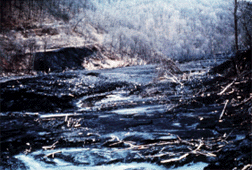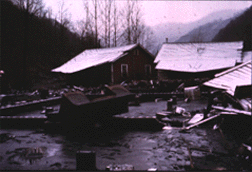

In the days preceding February 26, 1972, rain fell almost continuously, although experts later claimed this was typical for late winter weather in the area. Buffalo Mining officials, concerned about the condition of the highest dam, measured water levels every two hours the night of the twenty-fifth. Although a Pittston official in the area was alerted to the increasing danger, the residents of the hollow were not informed. The company sent away two deputy sheriffs, who had been dispatched to assist with potential evacuations. Despite the lack of warning from company officials, some residents sensed the danger and moved to higher ground. |
 |
|
Just prior to 8:00 a.m. on February 26, heavy-equipment operator Denny Gibson discovered the water had risen to the crest of the impoundment and the dam was "real soggy." At 8:05 a.m., the dam collapsed. The water obliterated the other two impoundments and approximately 132 million gallons of black waste water rushed through the narrow Buffalo Creek hollow. |
| In a matter of minutes, 125 were dead, 1,100 injured, and over 4,000 left homeless. |  |
 |
One thousand cars and trucks were destroyed. |
| The flood demolished 502 houses and 44 mobiles homes and damaged 943 houses and mobile homes. Property damage was estimated at $50 million. |  |
 |
The 15- to 20-foot black wave of water gushed at an average of 7 feet per second and destroyed one town after another. A resident of Amherstdale commented that before the water reached her town, "There was such a cold stillness. There was no words, no dogs, no nothing. It felt like you could reach out and slice the stillness." -- quote from Everything in Its Path, by Kai T. Erikson |
| Another resident commented on the rushing tide, "This water, when it came down through here, it acted real funny. It would go this way on this side of the hill and take a house out, take one house out of all the rows, and then go back the other way. It would just go from one hillside to the other." -- quote from Everything in Its Path, by Kai T. Erikson |  |
|
|
The flood water first emptied into the Guyandotte River at Man at 10:00 a.m. By 11:00, all of the flood water had poured into the Guyandotte and virtually everything in its path was gone. |
 |
 |
 |